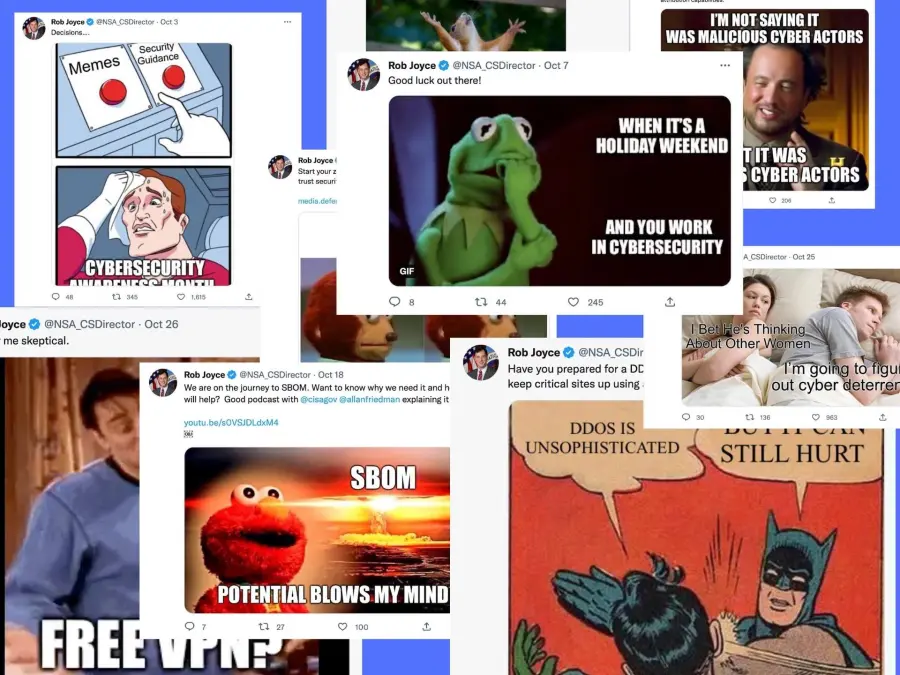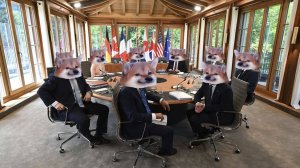Spy agency embraces meme culture and the internet is here for it

If you didn’t know any better, you might think a teenage hacker commandeered Rob Joyce’s Twitter account.
The cybersecurity director of the National Security Agency has posted one meme after another nearly daily over the month of October (yes, it’s for Cybersecurity Awareness Month). And he’s been hitting all the internet’s favorites: a cackling Leonardo DiCaprio, Elmo with mushroom cloud and celebrating squirrel, to name a few.
Despite the spy agency’s staid reputation and typically reserved approach to media, Joyce is succeeding at using humor to bring more attention to the NSA, and its mission, if the number of likes and shares are any indication.
But Joyce’s meme affinity also suggests the Department of Defense more broadly may have finally figured out how to use internet culture to its advantage. In the recent past, the national security establishment demonstrated that it just didn’t get it when it came to social media.
Exhibit No. 1: The failed “silly bear” meme that U.S. Cyber Command spent weeks to create.
Memes can be tricky to execute well — particularly if you’re the NSA — but often go viral and have emerged as important tools for those who want to communicate complex information in a simple way for a mass audience.
For example, the NAFO “fellas” — who tweet ridiculous memes at Russian officials and sympathizers — have drawn significant support in online military and cybersecurity communities that have circulated the posts backing Ukraine in its war against Russia. In one case, a NAFO fella managed to engage a senior Russian government official in a public spat.
Joyce’s memes have ranged from silly to saucy. Last Tuesday, he posted one featuring a man in bed looking at his phone beneath the caption: “I’m going to figure out cyber deterrence.” Meanwhile, his frustrated wife gazes at the opposite side of the bedroom and muses, “I bet he’s thinking about other women.”
As with all things on Twitter, memes will have their critics, too. A Twitter user with the handle CyberJack retweeted the image with this caption: “Imagine going thru a rushed TS/SCI & full poly & SF-86 for an NSA internship and then having to crank out memes at 530 am on weekdays.”
Another meme about the software bill of materials features Sesame Street’s Elmo next to a mushroom cloud and the caption, “SBOM potential blows my mind.” One Twitter user bristled: “Maybe not the best time to use mushroom cloud imagery.. just sayin.”
A third featured a Yoda-like figure nodding off to sleep under the caption “Me after a long week of doing cyber.” Cybersecurity threat analyst Kevin Beaumont tweeted his reply: “Speak for yourself, I’m stuck in a leap year due to Microsoft 365.”
Joyce told CyberScoop a team helps with the memes, which have alternately featured “I Love Lucy,” “The A-Team” and Eddie Murphy in “Coming to America.” (The NSA is not alone in embracing memes — Cybersecurity and Infrastructure Security Agency Director Jen Easterly also has been known to tweet them).
In an emailed statement to CyberScoop, Joyce said his tweets are part of an effort to raise awareness of cybersecurity issues.
“Tech folks have been communicating through memes for years, so during Cybersecurity Awareness month this seemed a good way to generate interest in important topics, but in a lighthearted way,” the statement said. “We can take ourselves too seriously at times, and much of the advice gets tired or overworked during this month especially. The memes we create ourselves make our guidance memorable.”
Linguists say memes were important long before the internet. But memes have increasingly become a fixture online and tend to go viral more than other posts, making them an especially appealing vehicle for public officials hoping to impact the broadest audience possible.
In addition to the NAFO fellas using memes to troll Russia, Ukraine is using social media to their advantage. The Ukrainian government has frequently highlighted memes on agency websites and officials have publicly thanked online communities that spread anti-Russian messages. The Ukrainian defense ministry in August even showed the internet’s favorite dog, a Shiba Inu, in a military uniform appearing to cheer on a missile launch.
While it might be surprising for the NSA to use memes to communicate cybersecurity imperatives, the nature and themes of the agency’s memes are on brand, according to Sylvia Sierra, a linguist and meme expert who is a communications and rhetorical studies professor at Syracuse University.
“At first when I saw the NSA Cyber Director was tweeting out memes, I thought maybe it was an intern that was running the account,” Sierra told CyberScoop.
But Sierra said she quickly realized Joyce or his contemporaries must be producing the content since he is tweeting “mostly ‘old-school’ memes that feature the Impact font laid over images.” Sierra said this style of meme was popular in the early 2000s.
She said that since Joyce is a Gen Xer, his exposure to memes and internet culture probably dates to the early aughts, explaining why he and his team haven’t “stayed up to date with all the newest meme trends.”
But Joyce’s Twitter followers probably skew older anyway, Sierra said, making his dated take on memes less of an issue. She said that based on the commentary and engagement his memes receive, Joyce appears to be connecting.
The memes, Sierra said, “probably make him seem ‘cool’ to them.”






